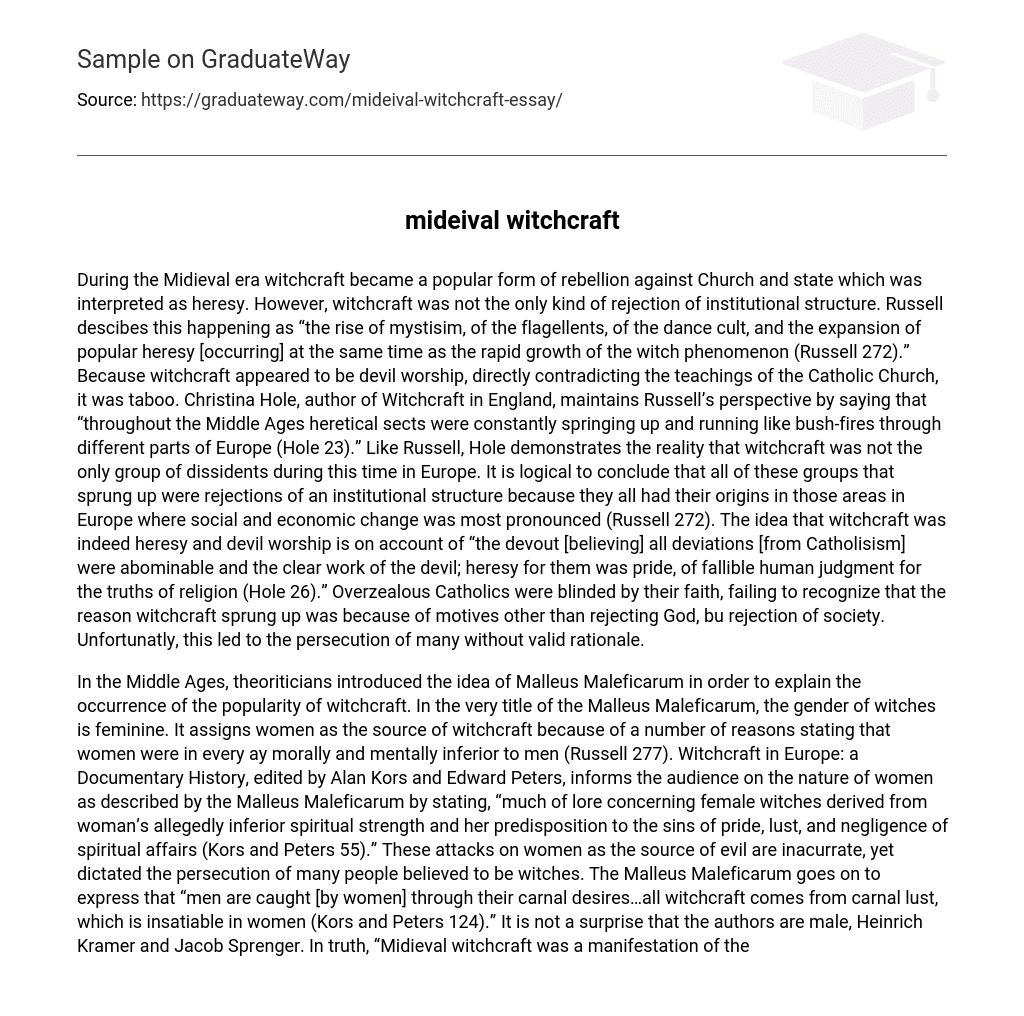During the Midieval era witchcraft became a popular form of rebellion against Church and state which was interpreted as heresy. However, witchcraft was not the only kind of rejection of institutional structure. Russell descibes this happening as “the rise of mystisim, of the flagellents, of the dance cult, and the expansion of popular heresy [occurring] at the same time as the rapid growth of the witch phenomenon (Russell 272).” Because witchcraft appeared to be devil worship, directly contradicting the teachings of the Catholic Church, it was taboo. Christina Hole, author of Witchcraft in England, maintains Russell’s perspective by saying that “throughout the Middle Ages heretical sects were constantly springing up and running like bush-fires through different parts of Europe (Hole 23).” Like Russell, Hole demonstrates the reality that witchcraft was not the only group of dissidents during this time in Europe. It is logical to conclude that all of these groups that sprung up were rejections of an institutional structure because they all had their origins in those areas in Europe where social and economic change was most pronounced (Russell 272). The idea that witchcraft was indeed heresy and devil worship is on account of “the devout [believing] all deviations [from Catholisism] were abominable and the clear work of the devil; heresy for them was pride, of fallible human judgment for the truths of religion (Hole 26).” Overzealous Catholics were blinded by their faith, failing to recognize that the reason witchcraft sprung up was because of motives other than rejecting God, bu rejection of society. Unfortunatly, this led to the persecution of many without valid rationale.
In the Middle Ages, theoriticians introduced the idea of Malleus Maleficarum in order to explain the occurrence of the popularity of witchcraft. In the very title of the Malleus Maleficarum, the gender of witches is feminine. It assigns women as the source of witchcraft because of a number of reasons stating that women were in every ay morally and mentally inferior to men (Russell 277). Witchcraft in Europe: a Documentary History, edited by Alan Kors and Edward Peters, informs the audience on the nature of women as described by the Malleus Maleficarum by stating, “much of lore concerning female witches derived from woman’s allegedly inferior spiritual strength and her predisposition to the sins of pride, lust, and negligence of spiritual affairs (Kors and Peters 55).” These attacks on women as the source of evil are inacurrate, yet dictated the persecution of many people believed to be witches. The Malleus Maleficarum goes on to express that “men are caught [by women] through their carnal desires…all witchcraft comes from carnal lust, which is insatiable in women (Kors and Peters 124).” It is not a surprise that the authors are male, Heinrich Kramer and Jacob Sprenger. In truth, “Midieval witchcraft was a manifestation of the innate and perennial darkness of the human soul (Russell 279).” The notion that women are inferior to men and the source of sin continued to prevail throughout history, aiding in the discrimination of the female race.
Despite persecution, a following of witchcraft remained. Russell’s explanation of this event is, “one might chose to embrace witchcraft in the hope of avoiding death either by obtaining a share of eternal life in the Devil’s kingdom or by displacing fear if implacable death with fear of a Devil whom one can at least mollify (Russell 275).” The segment of society that did not believe in the Church still needed to feel the security and guidence of a faith. Neither the Church or state could provide them with this. These people were forced to compensate fot this themselves, and “as paganism receded into the mists of history, those who questoned Christianity began to produce new doctrines which varied from mild modifications of Christian practice to a flat denial of the fundamental tenents of Christian belief (Hole 24).” The people that rejected the Church did so in dergrees of small alterations to complete worship of the devil. In some cases, the community of witches was not a heretical sect, but a survival of paganism. Either way, all forms were considered to be witchcraft and these people were sought after for persecution.
Hole, Christina. Witchcraft in England. London: B.T. Bashford Ltd., 1947.
Jeffery Burton Russell. Witchcraft in the Middle Ages
Witchcraft in Europe: 1000-1700 A Documentary History. Ed. Alan C. Kors and Edward Peters. Philadelphia: University of Pennsylvania Press, 1972





